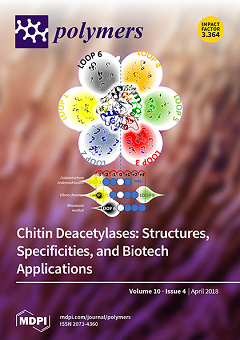Wooden magnetic activated carbon fibers (WMACFs) with hierarchical pore structures were obtained by adding magnetic iron oxide (Fe
3O
4) nanoparticles into the liquefied wood. The structures and properties of WMACFs were analyzed by scanning electronmicroscopy (SEM), X-ray diffraction (XRD), Fourier
[...] Read more.
Wooden magnetic activated carbon fibers (WMACFs) with hierarchical pore structures were obtained by adding magnetic iron oxide (Fe
3O
4) nanoparticles into the liquefied wood. The structures and properties of WMACFs were analyzed by scanning electronmicroscopy (SEM), X-ray diffraction (XRD), Fourier transform infrared spectroscopy (FTIR), N
2 adsorption, and vibrating sample magnetometer (VSM). The results showed that WMACFs had high Brunauer-Emmett-Teller (BET) surface area (1578 m
2/g) and total pore volume (0.929 cm
3/g), of which 45% was the contribution of small mesopores of 2–3 nm. It is believed that Fe
3O
4 nanoparticles play an important role in the formation of hierarchical pores. With the Fe
3O
4 content increasing, the yield rate of WMACFs decreased, and the Fe
3O
4 crystal plane diffraction peaks and characteristic adsorption peaks were obviously observed. At the same time, it was also found that WMACFs had favorable magnetic properties when the Fe
3O
4 content was above 1.5%. As a result, WMACFs could be a promising candidate for high efficiency, low cost, and convenient separation for the magnetic field.
Full article






